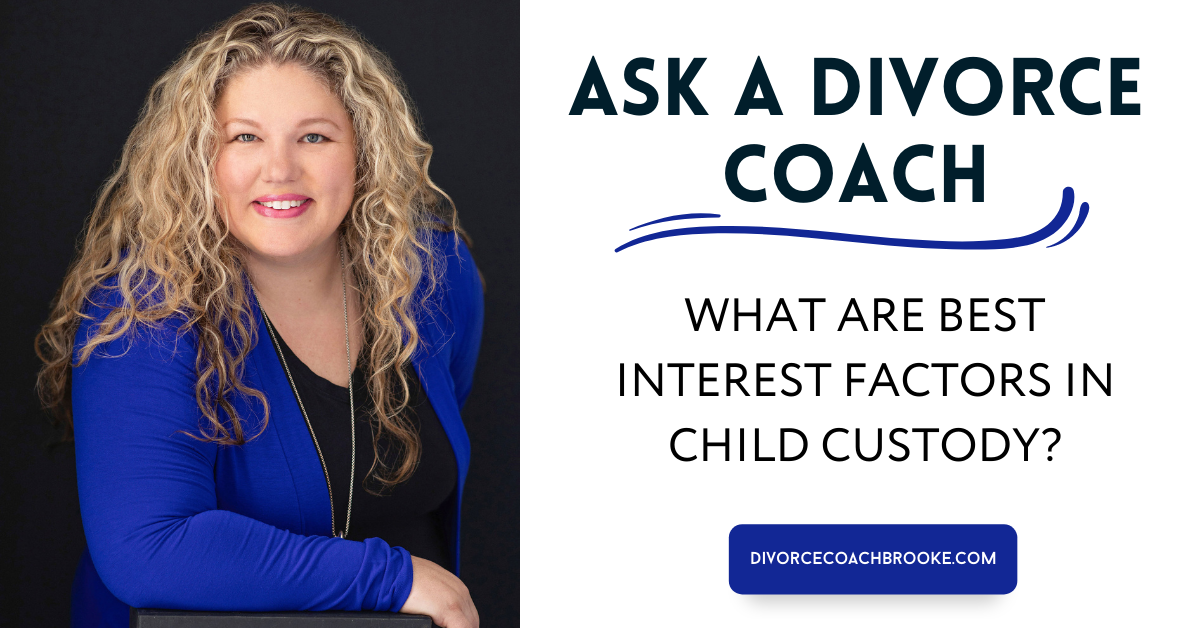
What are Best Interest Factors in child custody?
When courts determine child custody, they use the best interest of the child standard, which considers several important factors to ensure the child’s overall well-being is prioritized. These factors help guide decisions about where the child should live, how much time they will spend with each parent, and who will be responsible for making key decisions in the child’s life. While each case is unique, the following are some of the most commonly used best interest factors that courts consider when determining custody.
What are the best interest factors?
The best interest factors in child custody vary depending the jurisdiction (or location) where the custody dispute is taking place. Each state has its own set of laws regarding custody, and those can generally be found by googling “best interest factors in child custody in [put your state here].” However, there are several common factors that are generally considered by courts when making custody determinations. These include:
-
The child’s age, gender, and developmental stage
The child’s age, gender, and developmental stage play a key role in determining their needs and the type of care required. For example, an infant may need more frequent interaction with the primary caregiver, while an older child may benefit from maintaining strong ties with both parents. Developmental needs can also influence decisions regarding schooling, healthcare, and emotional support. Courts consider how well each parent understands and can meet the child’s needs based on their developmental stage.
-
The child’s relationship with each parent and other important people in their life, such as siblings, grandparents, and extended family members
Courts assess the child’s relationship with each parent and other key individuals in their life, such as siblings, grandparents, and extended family members. A positive, healthy bond with each parent is crucial, as is maintaining strong connections with siblings and other important people. Judges aim to create a custody arrangement that preserves these important relationships, recognizing the emotional and social support they provide to the child. Courts may also take into account the consistency of these relationships over time and how involved each parent has been in the child’s daily life.
-
Each parent’s ability to provide for the child’s physical, emotional, and educational needs
Each parent’s ability to meet the child’s physical, emotional, and educational needs is central to determining the best custody arrangement. This includes providing essentials like food, shelter, and healthcare, as well as emotional support and guidance. Courts will evaluate how each parent can support the child’s education, whether that means helping with schoolwork, attending parent-teacher meetings, or ensuring the child participates in extracurricular activities. The ability to create a nurturing and secure environment that fosters emotional well-being is crucial in these decisions.
-
Each parent’s mental and physical health
A parent’s mental and physical health can significantly impact their ability to care for the child. Courts assess whether a parent is physically and emotionally capable of meeting the child’s needs. If a parent has a mental or physical health condition that affects their ability to provide consistent care, this could influence the custody arrangement. However, courts are also mindful not to discriminate based solely on a diagnosis; they focus instead on how the condition affects the parent’s ability to parent effectively.
-
The child’s preference, if the child is mature enough to express one
In some cases, courts will consider the child’s preference regarding where they want to live, provided the child is mature enough to express a reasoned opinion. The weight given to the child’s preference depends on their age and emotional maturity. While the court considers the child’s input, it ultimately balances their wishes with other factors to ensure the decision is in the child’s best interest.
-
The ability of each parent to provide a stable and consistent home environment for the child
A stable and consistent home environment is essential for a child’s well-being. Courts look at each parent’s ability to offer stability, including a safe living situation, a routine that supports the child’s development, and consistency in caregiving. Stability is particularly important for younger children, who need a structured environment to thrive. Courts may favor the parent who can maintain a stable household, especially if the other parent’s situation is more transient or unpredictable.
-
Each parent’s willingness to encourage and support the child’s relationship with the other parent
A parent’s willingness to encourage and support the child’s relationship with the other parent is a key factor in custody decisions. Courts prefer to grant custody to a parent who fosters healthy co-parenting and ensures that the child has a strong relationship with both parents. If one parent actively discourages or undermines the child’s relationship with the other parent, this behavior could negatively impact their custody outcome. Courts value cooperation and the ability to prioritize the child’s needs over personal conflict. *See Additional Comments below*
-
Any history of domestic violence, substance abuse, or other issues that could impact the child’s safety and well-being.
Finally, the court will carefully consider any history of domestic violence, substance abuse, or other issues that could impact the child’s safety and well-being. If a parent has a history of abuse, substance addiction, or other dangerous behaviors, the court may limit or supervise their custody or visitation rights to protect the child.
These factors are given different weights depending on the state and circumstances. However, it’s really important to understand the best interest factors before developing a parenting plan. It’s also really important as you look at your ongoing relationship with your ex-partner. Domestic violence is A factor in many jurisdictions. But it is not the only factor. (I would argue as would most of my colleagues that it should be the MOST IMPORTANT factor in custody decisions, but it often is not. Abusive parents get court-ordered, unsupervised custody and visitation every single day.)
* Willingness to encourage and support the child’s relationship with the other parent
The willingness of each parent to support the children’s relationship with the other parent is debated and contested in domestic violence spaces. But it is on the books in many places. What this means is that even if a parent threatened to kill the other parent – even if a parent threatened to kill the child – the other parent is theoretically supposed to encourage and support the child’s relationship with the person they consider dangerous. Not doing so can be labeled as “parental alienation” and can jeopardize a protective parent’s entire case. (There are certainly examples of judges recognizing the danger of domestic violence and protecting kids in these cases. It is very important to talk to your attorney about this, and you should ask specifically how to navigate your concerns while also meeting the willingness to encourage relationship best interest factor.)
The complexity of the best interest factors is one of the reasons why communicating with a disordered ex-partner is such an important strategic part of your post-divorce plan. In my case, the judge decided that I didn’t like X (I didn’t – for good reason), but the fact that she could tell hurt my case for several years. I know better now!
A divorce coach can help you locate resources to better educate yourself on your state’s best interest factors so that you can be strategically-minded during your ongoing custody battle.
Learn More
Finding One Mom’s Battle and Divorcing a Narcissist
As my world began to unravel, and I started to question everything that I believed about my family and the previous ten years of marriage, I started researching. The problem was that I was terrified of X. He seemed to know where I was, what I was doing, and who I was talking to AT ALL TIMES. How was I going to research my situation without him finding out (just as a PSA – if you are worried about how to google without enduring the wrath of your husband, I give you FULL permission to read that as a huge RED FLAG and get the hell out of there!).
I wasn’t sleeping much as it was, my anxiety about the situation growing. The problem with waking up to the reality of an abusive marriage is that once you are aware, you have to do something about it. You CAN stay, but even that becomes a choice once you are cognitively awake. X liked to stay up until the early hours of the morning before going to sleep. So I would wake up about 4 am, sneak downstairs, curl up on the couch, and hide under a blanket so he couldn’t see the websites I was visiting if he did wake up. I wasn’t certain whether there was a keylogger on my phone monitoring my web traffic – I considered it at least a high possibility. But I needed information, so I took the chance.
I don’t remember how I got to narcissism from my search terms. Despite growing up in a toxic and abusive family system, narcissism wasn’t a word I was particularly familiar with. Boundaries were definitely not a part of our vernacular! One of the websites I found was Out of the Fog, which helps those whose family members have personality disorders. I read a lot of personal stories there, which finally gave me the words to describe what was happening. It’s one of the reasons I share my story. Reading academic text is fine, but it’s others’ stories that truly connect us and help give us the strength to make different choices.
One Mom’s Battle
One early morning, I found Tina Swithin through One Mom’s Battle and her book Divorcing a Narcissist. While I was becoming aware that there was probably no way forward in my marriage, the One Mom’s Battle blog showed me what I would likely face if I decided to get a divorce. X had sent me something he called a Holographic Postnuptial Agreement that gave me full custody and all of our assets. But I didn’t trust anything he said anymore, and I didn’t know how the court would intervene even with that document. X also said on several occasions that if we got divorced, the kids and I would never see him again (spoiler alert: he lied).
I’m going to jump ahead a bit in my story, and I will go back in another post and fill in the gaps. After I asked for a divorce, I scheduled a call with Tina. I didn’t know what a divorce coach was. In 2016, I don’t think that’s what we were calling them. All I knew is that she had been there and that I needed validation. A LOT OF VALIDATION.
Some people use divorce coaches regularly. That wasn’t quite my strategy. I needed someone to hear how crazy things were, let me know that I wasn’t out of touch with reality or overbearing for wanting to protect my kids. I also found that Tina Swithin knew strategies and techniques (like asking for a nail test instead of just a hair follicle test for drugs).
When my ex-husband’s parental rights were terminated, one of the first phone calls I made was to Tina. I think I was a blubbery mess! I wanted her to know that I was free and that I couldn’t have done it without her.
Tina and One Mom’s Battle now train others to become high-conflict divorce coaches. I am certified through her program, the High-Conflict Divorce Coach Certification Program. Tina has taken the knowledge she has gotten from One Mom’s Battle, from Divorcing a Narcissist (Sociopath) and made it accessible to many more of us. I have the knowledge of my own divorce and family court battle, but I also have the collective knowledge from Tina and all of the other high-conflict divorce coaches who have been through the program.
I will forever be grateful to her for sharing her story, for finding her one early Spring morning, curled up under a blanket, not knowing where to turn.
Learn More
I was named a Woman of the Year. It was the lowest night of my life.
 It should have been the highest moment of my life, being recognized as one of Idaho’s Women of the Year at the age of 34.
It should have been the highest moment of my life, being recognized as one of Idaho’s Women of the Year at the age of 34.
Instead, it was one of my lowest.
Outwardly, I had achieved everything. I had helped lead the social media campaign that raised $12 million to save my college. I was married to a seemingly successful entrepreneur who had invented virtual reality technology that got us meetings with Disney, Samsung, Google, Intel. I had two beautiful children.
I had outer success, external validation.
But inside? Inside I was a mess.
It had been a mere week or two since my aha moment where I had entertained the possibility that I was in an abusive marriage. After I had gotten home that day, I started keeping track of all of the bizarre goings on with my husband.
“I think I’m being emotionally abused,” I said to him, still unsure what to even call the last ten years of marriage. I thought if I told him that his behavior was abusive, he would change. Or I would fix him. My husband had a way of making you think he was incompetent instead of deliberately manipulative. And then we could go on pretending that everything was fine. I would still have to ignore the multiple Ashley Madison accounts and the emails I had found soliciting women on Craigslist. In my mind, those weren’t character problems. They were impulsive one-offs. At least that’s what I believed until that February day.
Bizarrely, my husband said in response, “I’m so happy. I’m so happy.” It seemed like an odd thing to say after your wife tells you they are concerned there is a decade of abuse to untangle. “You will be honest with me now” he added.
He then got down on one knee (which is more than he did when we got engaged, to be honest) and said “If I change, will you marry me in six months?” I think he was trying to distract me, turn my focus to planning a vow renewal. But I wasn’t interested in that, not this time. I was already starting to see that words weren’t enough. I’d have to see actual behavior changes.
Over the next week, he would say things like “I can sense people’s emotions so I know when you are lying to me” or “Everyone thinks you’re a bitch.” It was unnerving, at best.
What I started to notice were the ways I was being forced to stay in constant contact with him. If he sent me a text and I waited even ten or fifteen minutes to respond, he would accuse me of ignoring him or doing something deceptive to undermine him. Once we started talking, I would endure ongoing rants that could last for thirty minutes to an hour – or longer. It was exhausting.
On the night of the Women of the Year banquet, my mom, sister, husband, and the few friends I still managed to stay in touch with came to honor and celebrate me. I already knew that my husband hated that I was getting this award. He thought it should be him (even though he wasn’t a woman). He especially hated that a man nominated me for the award. All day long, he sulked about my being recognized. And then once we got there, he started acting like I was going to be given an even bigger award. I knew that I wasn’t. And I wondered if he was trying to set me up for disappointment.
It was finally time for all of the honorees to be called on stage and individually recognized for our contributions over the previous year. I stood in the dark behind the stage with my head down. I’m a fraud. I don’t deserve this. How can I accept an award when I can’t even stand up for myself?
It would be easy to blame X for those thoughts. He certainly made me feel small and undeserving. But these weren’t his thoughts – not anymore. These were mine.
I looked like I had it all from the outside. But no one could see the inner turmoil and struggle. If I was the strong woman they were about to celebrate on stage I would leave. But if I was the good girl, the pleaser, the fixer, the person I believed that the world truly wanted me to be, I would stay.
I held back my tears and plastered my fake smile across my face as they announced my name. Wife. Mother. Leader. Friend. Imposter.
Learn MoreI didn’t know I was in an abusive marriage

In 2016, after 10 years of marriage to a controlling man, I looked tired all the time. I felt dead inside. Eventually the joy did come back, but it took a lot of work!
I was in an abusive marriage for 10 years. But I didn’t know it.
On February 18, 2016, my life changed. I woke up, or I pulled myself out of the fog, as they say in narcissistic abuse communities.
X and I had a startup together. At one point I walked away from running it, but eventually, I got sucked back in, managing the day-to-day operations, trying to secure funding, and giving away all of my money to my partner to fulfill his dreams. As a startup founder, I was invited to a local networking group that met weekly-ish. That February morning, I dropped the kids off at school and rushed into town to meet up with the group.
Several years prior, half of my face had been suddenly paralyzed (a couple of months after my house burned down and a few weeks after my first son was born). It wasn’t a good year! When I got to my networking group, one of the other founders also had Bell’s Palsy, the facial paralysis. While we talked a bit about business, I also talked to him about what helped me and my own health journey after.
I left the co-working space and walked out into the chilly winter day. My plan was to get in my car and head home to work. As I was walking down the street, I was thinking about how to hide this meeting from X. I knew he didn’t like it when I attended.
What if he finds out?
Those words initiated the alarms in my head. It was as though the batteries to the smoke detector had been dead for far too long, and that phrase was a brand new rechargeable set that alerted me to the fact that the fire was in the building.
What if he finds out?
I stopped and stared at the concrete. Was I in an abusive marriage? Was I in a controlling relationship? Was my husband creating fear and doubt in all of my relationships to isolate me so that I would depend on him, and him alone? Why would he get mad at me for attending a business meeting, especially one that was for the benefit of his company? In part, he didn’t want me attending alone. Wherever we went, it had to be together, always in sight of X to monitor my movement and behavior. Part of it was that he wanted to be the one invited. The product was his idea. Why was I the one to be asked to join the group? But mostly, it was because there were men there.
I was in my mid-thirties. Why was I not allowed to speak to other men?
This was my aha moment, the one that shifted everything else that would come after. It was the moment I started to question if I was in an abusive marriage. It was the first step in getting out. It was the thought that had me retracing the previous ten years, sifting through my memories looking for every red flag as though I were a contestant on Double Dare on Nickelodeon.
I believe our lives are made up of critical junction points that define our Befores and our Afters. That day, that moment, that thought, was one of the most important pivot points of my life.
Learn More
What’s the difference between a divorce coach and an attorney
In the midst of a high conflict divorce, individuals often find themselves navigating complex emotions, legal challenges, and contentious interactions with their ex-partner. To help manage these difficulties, two key professionals that may come into play are a high conflict divorce coach and an attorney. While both professionals can provide valuable support during a divorce, their roles and focus differ significantly.
Role of a High Conflict Divorce Coach
A high conflict divorce coach is a professional who specializes in helping individuals manage the emotional and interpersonal challenges that arise during a contentious divorce. Their primary focus is on providing emotional support, conflict management strategies, and practical guidance to help their client cope with the stress and upheaval of the divorce process.
High conflict divorce coaches are often trained in areas like conflict resolution, communication techniques, and emotional regulation. They work with clients to help them navigate difficult interactions with their ex-spouse, especially when that person exhibits high-conflict traits such as manipulation, narcissism, or aggressiveness. One of their key goals is to help clients stay calm, focused, and strategic during interactions with the other party, rather than reacting emotionally.
In addition to emotional support, a divorce coach may also help with goal-setting, decision-making, and planning for life after divorce. They often assist clients in organizing their thoughts and priorities, ensuring that their approach to the divorce aligns with long-term personal and parenting goals. High conflict divorce coaches are particularly useful for parents who are co-parenting with a difficult ex-partner, offering strategies to minimize conflict and protect the children from the emotional toll of the divorce.
While a high conflict divorce coach can offer invaluable guidance, it’s important to note that they do not provide legal advice. Their role is to help clients with the emotional and strategic side of the divorce, focusing on how to manage stress and conflict in a constructive way.
Role of an Attorney
An attorney, on the other hand, is a legal professional whose primary role is to advocate for their client’s legal rights during the divorce process. Divorce attorneys are responsible for handling the legal aspects of the case, including filing paperwork, negotiating settlements, representing their client in court, and ensuring that all legal procedures are followed.
Attorneys focus on the legal outcomes of the divorce, such as property division, child custody, spousal support, and child support. Their job is to protect their client’s legal interests and secure the best possible outcome within the framework of the law. In high conflict divorces, attorneys are often required to engage in aggressive litigation, manage complex negotiations, and advocate for their client’s position in a courtroom setting.
While an attorney may offer advice on how to approach certain interactions with the ex-spouse or how to avoid escalating conflict, their primary role is not to provide emotional support. Their focus is legal strategy and ensuring that their client’s rights are upheld throughout the divorce process.
Key Differences
The main difference between a high conflict divorce coach and an attorney lies in their areas of expertise and focus. A divorce coach offers emotional support, conflict management, and guidance on how to handle difficult interpersonal dynamics, while an attorney handles the legal proceedings and ensures that the client’s legal rights are protected.
A high conflict divorce coach may help you manage your emotions and develop strategies to avoid unnecessary conflict, but they cannot file legal documents, represent you in court, or offer legal advice. Conversely, an attorney can help you achieve a fair legal outcome in terms of property, custody, and finances, but they are not equipped to guide you through the emotional and psychological challenges of a high conflict divorce.
Learn More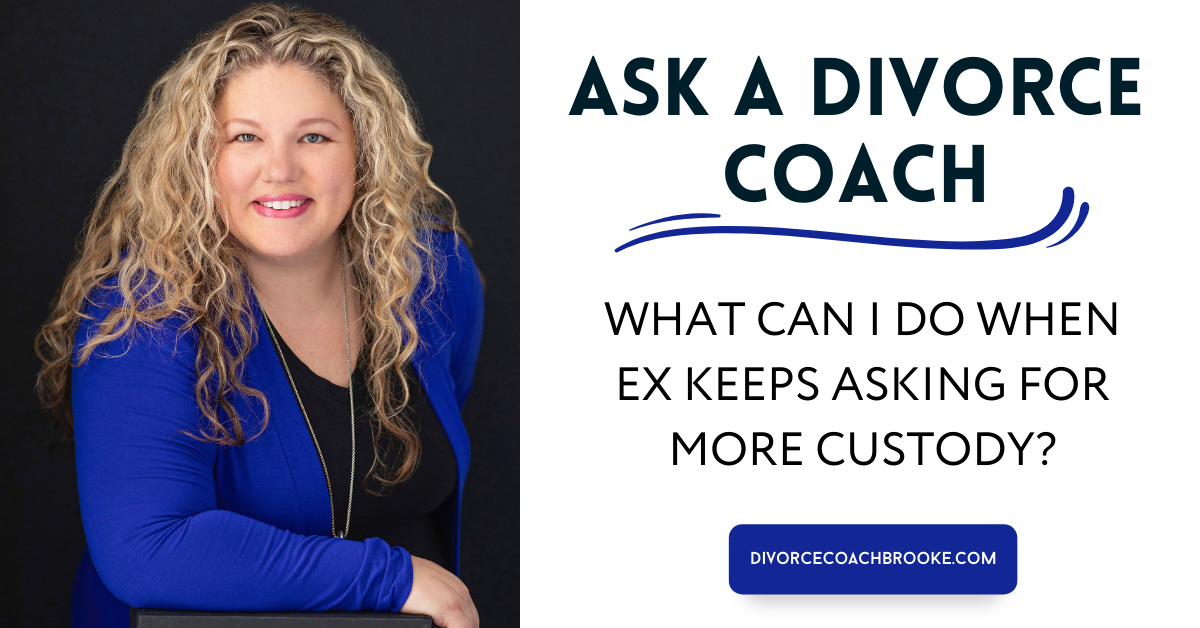
My ex keeps asking for more time. What can I do?
Step 1: Define your desired Outcome
During the first step, we work to define what is concerning you about the behavior and what the ideal outcome would look like. For a parent who is constantly asking to change the schedule, the concern might be consistency for the kids. If you are concerned about safety, these requests for extra time can provoke anxiety. A healthy parent may also be concerned that the disordered parent is going to file for more custodial time because they keep asking for more time. All of these concerns help us develop the desired outcome.
For this example, we’re going to say that the concern is both safety and a fear of the parent filing for more time in the future.
Step 2: Educate about family court and disordered traits
In order to develop an effective strategy, you must educate yourself about both disordered personality traits and family court. While I am unqualified to diagnose any unhealthy parent or partner, many of the parents seeking my services relate to behaviors consistent with having divorced someone exhibiting Cluster B (narcissism, sociopathy, borderline personality) symptoms.
In this specific situation, understanding the way that unhealthy parents want to create drama and arguments over what matters to you is an incredibly important step. Here are some Books to Read after Divorcing a Narcissist. If you say no to a request over additional time, it is likely that the unhealthy parent cues into that as a possible target for ongoing conflict. You will see how this matters when we discuss strategy.
Another important topic to educate yourself on is the realities of family court. 50/50 arrangements are seen as the default in most jurisdictions, even if there aren’t state laws requiring it. If a parent is expressing interest in a more equal parenting plan, the courts will likely, at minimum, hear that request.
Step 3: Brainstorm solutions
Now that we have identified the desired outcome and discussed personality traits and the family court system, it’s time to get creative! During this step, all we are trying to do is get unstuck and start to see that we have many options available to us. It may be tempting during this phase to leave out options because you don’t like them. I would challenge you to keep them on your list as you brainstorm. During the next step, you will pick a strategy that best suits your situation. And as you refine, you may come back to this list to try something new.
For a situation where an unhealthy parent is requesting more parenting time, here is a list of possible solutions.
- Say No to all requests for more time.
- Say No to all requests for more time but express a willingness to consider future requests.
- File a Motion requesting the judge clarify the order.
- Say Yes to all requests for time.
- Start offering more time.
- Start offering more time and express frustration when he doesn’t take the time he’s been offered.
This list is not exhaustive. See if you can come up with some of your own ideas.
Step 4: Develop a Strategy
We’ve gone through the steps and identified several paths forward. Now it’s time to put it all together. This step requires embracing a curiosity mindset. This basically means that you are going into a situation with questions and wondering what will happen rather than being afraid of the What-ifs. There is no right answer! In fact, I would suggest that I probably did all of these in my case! I’m going to analyze each of the options.
Say No to all requests
This seems completely logical if you are concerned with the safety of your children. However, when we apply our education step, we start to understand why this might be a problem. A disordered personality is going to latch on to any “No.” It’s a challenge. It’s an invitation to a fight. If your desired outcome is to minimize requests and stop the fight over more time, this is unlikely to help you achieve your goal. Furthermore, many states look at both parents’ cooperation in timesharing. If you always deny time, you can be labeled as controlling and uncooperative.
Say No to all requests for more time but express a willingness to consider future requests.
If you are going to deny requests for future time, this is likely a better approach. You are still denying the request, but you are doing so in a way that appears cooperative. You can also appeal to the disordered parent’s ego by saying things like “I know that you value consistency” or “Because you want what’s best for our kids.” Even if you don’t believe it, project positive traits onto the disordered parent so that you reduce the conflict. The disordered parent may continue their pursuit, however.
An email template might look like:
“Dear [parent],
Hope you’re doing well. I wanted to reach out in response to your recent request to take the kids on your noncustodial time. I appreciate that you’re interested in spending more time with them, but unfortunately, I’m going to have to say no for now.
As you know, we have a custody agreement in place, and I think it’s important that we stick to it to maintain some consistency for the kids. I don’t want to confuse them by changing things up too much.
I know this might be disappointing for you, and I’m sorry for that. I’m definitely open to talking about things in the future if your situation changes or if you have any other ideas for how we can adjust our custody arrangement to work better for all of us.
Thanks for understanding, and take care!”
File a Motion requesting the judge clarify the order.
You always have the option of going back to court. And the family courts have their place in this marathon. However, court is expensive. In this case, the court could clarify the motion, and the disordered partner may continue to do exactly what they have always done. You are still going to have to find a way to manage the situation on your own. Additionally, going to court exposes you to the potential that he will get more time through a court order. Use court with caution – and once you have solid evidence to present.
Say Yes to all requests for time.
Just like you have the option to say “no,” you also have the option to say “yes.” And for those of us who are conflict averse or accustomed to giving in to our ex’s demands, this can be very tempting. It *is* an option, but it should be considered carefully and only done strategically, not because you are used to ignoring your own wants and needs.
Start offering more time.
You might not see a difference between saying “yes” all the time and offering more time. But they are different! With this, instead of waiting for the disordered parent to ask, you are being proactive. You are taking the fight to him and forcing him to do what he says he wants, which is time. Because we know that these personalities often want the fight more than the actual request, we are creating a different fight. Many parents find that once they start asking the unhealthy parent to take time, they no longer do.
I know this feels scary. I can still feel the fear when I started to do this. But it can work.
Start offering more time and express frustration when he doesn’t take the time he’s been offered.
This is a variation on the above. When I first divorced, I told my ex-husband that I was frustrated when he didn’t take his scheduled overnights. I wasn’t really, but I wanted him to think it was annoying me. He did not take overnights for an entire year. It was a strategy that I was pretty sure would work, and unfortunately, I was talked out of listening to my own instincts about my case. I wish I had done it more, sooner. Offering time was one of the keys to my long-term strategy – and it was effective.
Step 5: Assess and Refine
It takes time to see if a new strategy will be effective. I recommend giving it three or four months to see a change. It’s also important to remember that when we try something new or set different boundaries, it can increase certain behaviors in the other person for a time, but then they burn out.
During this phase, you are keeping a curiosity mindset and collecting data. Once you feel like you have enough information, you can either continue, refine, or try one of your other ideas.
Have a Question about divorce or custody? Ask it here!
Learn More
What are the Best Books to Read after Divorcing a Narcissist?
Divorcing a narcissist or other difficult personality type can be extremely confusing and isolating. It may also be easy to think that the hard part is over, that he will finally leave you – and your children if you have them – alone. Often, it’s only just the beginning.
When I left my disordered ex-husband, I was just beginning to untangle the ten years of marriage to understand what exactly had happened to me. I wanted to be sure I didn’t do it again! So I started reading everything I could about narcissism, psychopathy, and healing. These are some of my favorite resources. I also have a page dedicated to book recommendations when divorcing a narcissist (Click on the image to go to Bookshop.com to order)
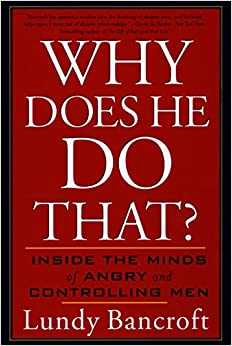
Lundy Bancroft has become a world-renowned expert on domestic violence and abusive men. In one of his most well-known books, Bancroft explains the psychology behind controlling behaviors and gives advice for how to extricate yourself from a toxic relationship.
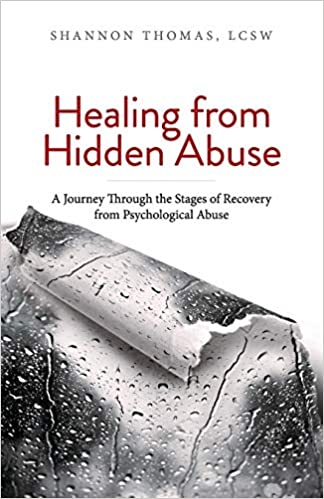
Shannon Thomas‘s book was life-changing for me. I have read and re-read this book (and if you listen to Audiobooks, it sounds like a therapist giving you personal, healing advice). For many people who have been in narcissistic and sociopathic relationships, it can be nearly impossible to describe what has happened to you. There are not always physical marks to explain the abuse. In Healing from Hidden Abuse, Shannon Thomas helps unravel the psychological damage and abuse, making you feel both validated and stronger as you heal.
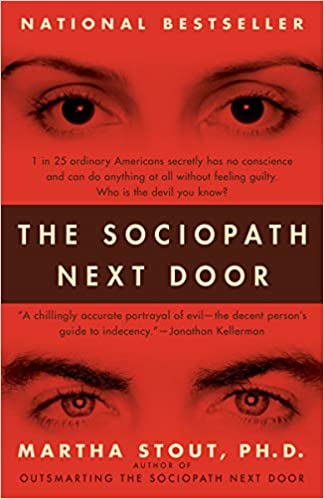
Not every high-conflict divorce involves a sociopath. But many, many do! And while the word has become over-used to describe every toxic individual, there are more sociopaths in the world than we would like to believe. They are not all in jail and do not all engage in the types of crimes that make for a good Netflix documentary! The Sociopath Next Door is such an incredible book, giving insight into the psychological minds of the disordered. Having the knowledge of how personality-disordered individuals think will help you make better decisions as you face divorce and child custody decisions.
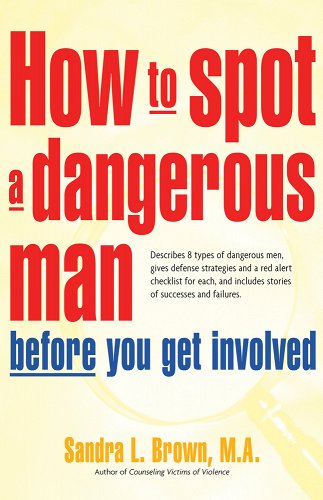
You might think this book would have been a better read BEFORE you met your ex-partner, but it still has invaluable and practical advice! I think it is a great read for anyone who plans to date again, for one. But I also think it can help you profile your ex-partner, which is an important part of the post-separation divorce process.
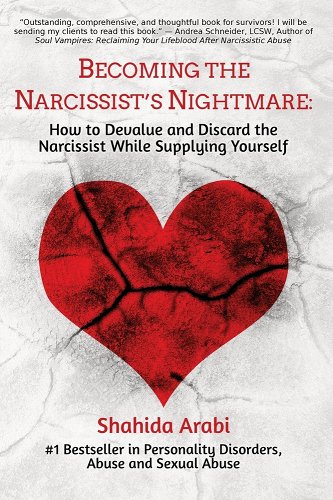
While most of the other books are focused on the disordered partner, this book is focused on those who have survived them! Shahida Arabi‘s book provides practical advice for setting boundaries, engaging in self-care, and empowering yourself to reclaim what you may have lost.
Learn MoreHave a question about high-conflict custody battles or divorcing a narcissist? Submit them here!
